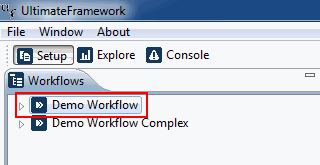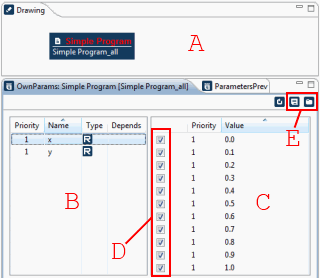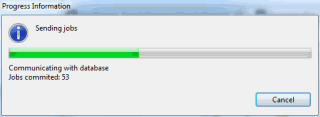Tutorial
Basic Lessons
- First-Time Setup and User Interface
- Example 1: A Simple Program
- Exploring Results: Basic Functionality
- Preparing Your Own Program
- Importing Your Own Program
- Creating Program Graphs
Advanced Lessons
- Automatically Finding Optimal Parameter Settings
- Example 2: Multiple Objectives
- Example 3: Parameter Dependencies
- Exploring Results: Advanced Functionality
- HPC and Database Configuration
- Program Graphs With Multiple Programs
Introductory Videos
Example 1: A Simple Program

 (We use the example database that is shipped with Ultimate Framework.
In case you didn't setup the example database, see the
First-Time Setup lesson for more information.)
(We use the example database that is shipped with Ultimate Framework.
In case you didn't setup the example database, see the
First-Time Setup lesson for more information.)
→ In the program graph collection, activate the Demo Program Graph.

 Now, you see in the Program Graph view the currently selected
Demo Program Graph (A). It only consists of a single
program, the Simple Program.
Now, you see in the Program Graph view the currently selected
Demo Program Graph (A). It only consists of a single
program, the Simple Program.
The Simple Program has two parameters, x and y (B). These parameters have the type real number, as you can tell by the symbol R in column Type. We want to find out which setting for x and y optimizes the evaluation function of Simple Program, its so-called objective.
→ Activate the x parameter by clicking on it.
Observe that the parameter value list (C) now displays the possible values of x. We already set up 11 values for x, namely the real values 0.0, 0.1, ..., 1.0.
In the parameter value list (C), you can see a check mark on the left of each value (D). When a check mark is set for a value, this value is included in the search for an optimal parameter setting. If a check mark is not set, this value is ignored in the search. The collection of included parameter values is called a selection in Ultimate Framework. A selection can be saved and loaded using the tool buttons (E). This makes it much easier to handle large sets of parameter values.
The more parameter values are included, the more jobs the Ultimate Framework has to execute in a search for an optimal parameter setting. A job is simply a run of your program, including the evaluation of its objective function.
For now, we just use all values that are set up for x and y.

 Have a look at the Parameter Settings Overview. You see three numbers:
Have a look at the Parameter Settings Overview. You see three numbers:
- Selected: 121
- Executed: 0
- Undone: 121
The meaning of "Selected: 121" is as follows. We have two parameters (x and y) with 11 values each. Because our selection includes all of them, we have a total of 11 × 11 = 121 different parameter settings, each resulting in a separate job that has to be executed.
Among these 121 selected jobs, none are executed so far. This explains the "Executed: 0" display. If we had executed some jobs before, this number would be greater than 0. Executed jobs are preserved between searches and are only deleted when you demand it via the Delete Results button.
The "Undone: 121" display results from the difference between the number of selected jobs (121) and the number of executed jobs (0).
→ Click the Execute ... button. A window appears that asks you to confirm your choice. This is done because executing a large collection of jobs can last very long.
→ Confirm your choice.

 Now, your jobs are executed on your local machine.
Now, your jobs are executed on your local machine.
For information on how to explore the results of the execution, see the Exploring Results: Basic Functionality lesson.
